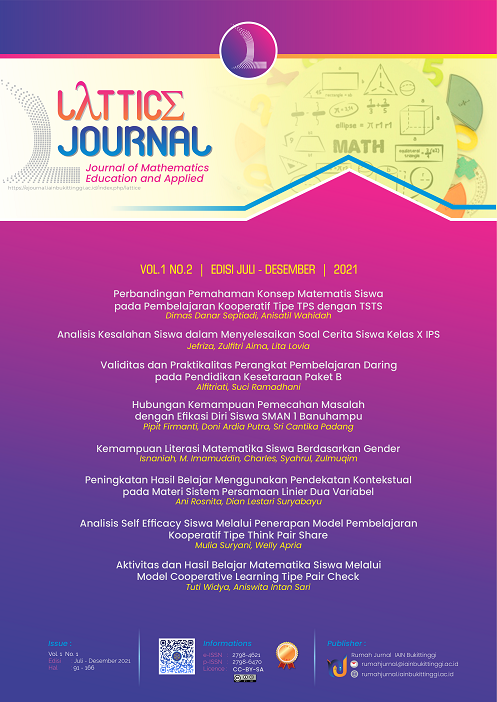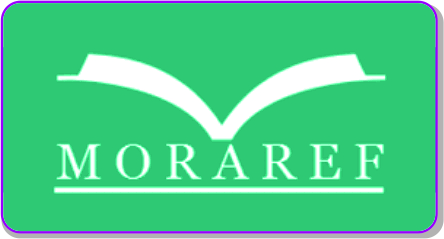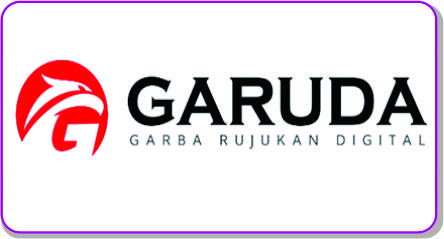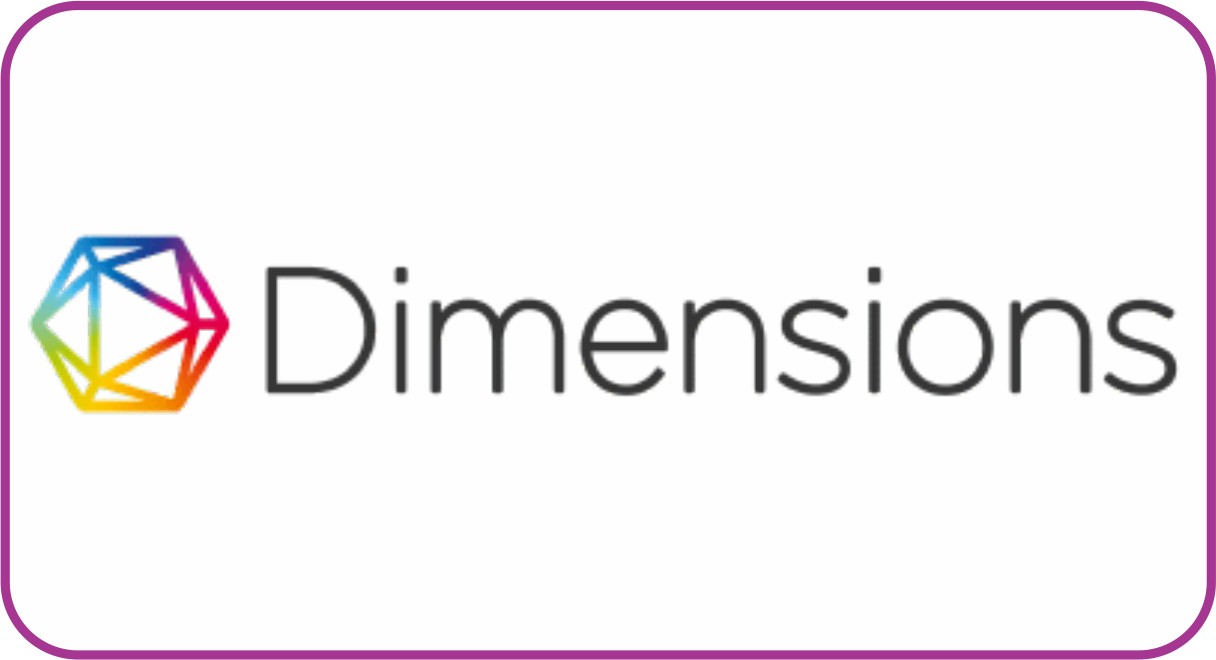Perbandingan Pemahaman Konsep Matematis Siswa pada Pembelajaran Kooperatif Tipe TPS dengan TSTS
DOI:
https://doi.org/10.30983/lattice.v1i2.4742Keywords:
Konsep Matematis, TPS, TSTSAbstract
This study aims to determine the differences in students' mathematical concept understanding abilities between those using the TPS type cooperative learning model and the quadrilateral TSTS type material in class VII students of SMP Negeri 7 Jember. This research is a quantitative research, while the type of research used is a quasi-experimental design with the non-equivalent posttest-only control group design. The population of this study was all seventh grade students of SMP Negeri 7 Jember for the 2018/2019 academic year, which was divided into 9 classes with a total of 317 students. Sampling was carried out using purposive sampling technique by taking 2 classes from 9 classes with certain considerations. The experimental class I (VII-E) of 36 students was given the TPS type of cooperative learning model and the experimental class II (VII-C) of 36 students was given the TSTS type of cooperative learning model. The data collection technique used documentation and test instruments (posttest) in the form of a description test of 6 questions. The data analysis technique used descriptive statistical analysis and inferential statistical analysis, namely the Z test. The results of the research through descriptive statistical analysis showed the average posttest result in the class using the TPS type cooperative learning model was 58,456 while the average posttest result in the class using the learning model cooperative type TSTS is 58,331. The results of inferential data analysis showed that the statistical test value Z=0.046 was less than the critical value Z_((0.05))=1.960 or 0.046<1.960. So H_0 is accepted and H_a is rejected. This means that it can be concluded that the average ability to understand mathematical concepts of students is the same between classes that use the TPS type cooperative learning model and those using the TSTS type cooperative learning model in the quadrilateral material for class VII SMP Negeri 7 Jember.
Penelitian ini bertujuan untuk mengetahui perbedaan kemampuan pemahaman konsep matematis siswa antara yang menggunakan model pembelajaran kooperatif tipe TPS dan tipe TSTS materi segiempat pada siswa kelas VII SMP Negeri 7 Jember. Penelitian ini merupakan penelitian kuantitatif sedangkan jenis penelitian yang digunakan adalah quasi eksperimental design dengan desain penelitian the non-equivalent posttest-only control group design. Populasi penelitian ini seluruh siswa kelas VII SMP Negeri 7 Jember tahun pelajaran 2018/2019, yang terbagi atas 9 kelas dengan jumlah 317 siswa. Pengambilan sampel dilakukan dengan menggunakan teknik purposive sampling dengan mengambil 2 kelas dari 9 kelas dengan pertimbangan tertentu. Kelas eksperimen I (VII-E) sebanyak 36 siswa diberi model pembelajaran kooperatif tipe TPS dan kelas eksperimen II (VII-C) sebanyak 36 siswa diberi model pembelajaran kooperatif tipe TSTS. Teknik pengumpulan data menggunakan dokumentasi dan instrumen tes (posttest) berbentuk tes uraian sebanyak 6 butir soal. Teknik analisis data menggunakan analisis statistik deskriptif dan analisis statistik inferensial yaitu uji Z. Hasil penelitian melalui analisis statistik deskriptif menunjukkan rata-rata hasil posttest pada kelas yang menggunakan model pembelajaran kooperatif tipe TPS sebesar 6 sedangkan rata-rata hasil posttest pada kelas yang menggunakan model pembelajaran kooperatif tipe TSTS sebesar . Hasil analisis inferensial data menunjukkan bahwa nilai uji statistik  kurang dari nilai kritis  atau . Sehingga  diterima dan  ditolak. Artinya dapat disimpulkan bahwa rata-rata kemampuan pemahaman konsep matematis siswa sama antara kelas yang menggunakan model pembelajaran kooperatif tipe TPS dengan yang menggunakan model pembelajaran kooperatif tipe TSTS pada materi segiempat kelas VII SMP Negeri 7 Jember.
References
D. W. Elang Krisnadi, Karso, Endang Wahyuningrum, Tarhadi, Pembelajaran Matematika SD. Jakarta: Universitas Terbuka, 2014.
N. N. Parwati, “Students’ Ability in Working the Mathematics Problem,†Proc. 5th Asian Educ. Symp. 2020 (AES 2020), vol. 566, no. Aes 2020, pp. 410–414, 2021, doi: 10.2991/assehr.k.210715.086.
L. O. Wilson, “Anderson and Krathwohl Bloom’s Taxonomy Revised Understandifile:///C:/Users/Situmorang/Desktop/Calon/Sepsis/BAB 1/Kerangka Pemikiran/BLOOM LENGKAP.pdfng the New Version of Bloom’s Taxonomy,†Second Princ., pp. 1–8, 2016.
N. L. and S. Robert reys, Lindquist, Lambdin D.V., Smith and M.N., Helping children learn mathematics. New york: John Wiley and Sons, Inc, 2001.
M. G. Gurat, “Mathematical problem-solving strategies among student teachers,†J. Effic. Responsib. Educ. Sci., vol. 11, no. 3, pp. 53–64, 2018, doi: 10.7160/eriesj.2018.110302.
A. Dendane, “Skills needed for mathematical problem solving’,†2009. .
N. Fadzillah, “Analisis Kesulitan Pemahaman Konsep Matematika Siswa Kelas VII SMP,†Universitas Muhammadiyah Purworejo, 2016.
R. Susanti, “Analisis Kesalahan Pemahaman Konsep Bangun Datar Pada Siswa Kelas V Min Sukosewu Gandusari Blitar,†vol. 10, no. September, pp. 87–110, 2018.
E. Anika, A. Hidayat, and K. Ediputra, “Kemampuan Pemahaman Konsep Matematis Siswa Kelas VIII melalui Model Pembelajaran Kooperatif Tipe Teams Games Tournament,†J. Cendekia J. Pendidik. Mat., vol. 2, no. 2, pp. 101–110, 2018.
K. P. dan Kebudayaan, “Peraturan Menteri Pendidikan dan Kebudayaan Republik Indonesia Nomor 58 tentang Kurikulum 2013 Sekolah Menengah Pertama/ Madrasah Tsanawiyah,†pp. 27–44, 2014.
M. R. Lestari, Karunia Eka, Penelitian Pendidikan Matematika, I. Bandung: PT Rafika Aditama, 2016.
S. H. Taniredja, Tukiran, Efi Miftah Taridli, Model-Model Pembelajaran Inovatif dan Efektif. Bandung: Alfabeta, 2014.
Haji isjorini, Cooperative learning : mengembangkan kemampuan belajar berkelompok / Isjoni, 9th ed. Bandung: Alfabeta, 2019.
A. Suparijono, Cooperative Learning Teori dan Aplikasi PAIKEM. Yogyakarta: Pustaka Pelajar, 2009.
Moch. Agus Krisno Budiyanto, Sintaks 45 Model Pembelajaran dalam Student Centered Learning (SCL). Malang: Universitas Muhammadiyah Malang, 2016.
D. P. and G. K. Meixia Ding, Xiaobao Li, “Teacher Interventions in Cooperative-Learning Mathematics Classes,†J. Educ. Res., vol. 100 no 3, pp. 162–175, 2007.
Goerge M. Jacobs and Christopher Ward, “ED444356.pdf,†Electron. J. Sci. Educ., p. 28, 2000.
I. N. L. Jayanta and G. N. S. Agustika, “A Comparison of the Effectiveness of Two Stay-Two Stray and Pair Checks Cooperative Learning Models Towards Primary School Mathematics Learning Outcomes,†Proc. 2nd Int. Conf. Technol. Educ. Sci. (ICTES 2020), vol. 540, no. Ictes 2020, pp. 1–5, 2021, doi: 10.2991/assehr.k.210407.205.
M. F. Agustian, “Perbandingan Model TSTS dengan TPS Terhadap Hasil Belajar TDO SMK PGRI Tanjung Raja,†J. Pendidik. Tek. Mesin, FKIP UNSRI, pp. 62–68, 2018.
S. Sagala, Konsep dan Makna Pembelajaran. Bandung: Alfabeta, 2003.
E. Istikomah, “The relationship between conceptual understanding and student learning outcomes through the use of geometers Sketchpad software,†J. Phys. Conf. Ser., vol. 1157, no. 4, pp. 9–13, 2019, doi: 10.1088/1742-6596/1157/4/042070.
Downloads
Submitted
Accepted
Published
Issue
Section
License
Authors who publish with Lattice Journal : Journal of Mathematics Education and Applied agree to the following terms: Authors retain copyright and grant the Lattice Journal : Journal of Mathematics Education and Applied right of first publication with the work simultaneously licensed under a Creative Commons Attribution License (CC BY-SA 4.0) that allows others to share (copy and redistribute the material in any medium or format) and adapt (remix, transform, and build upon the material) the work for any purpose, even commercially with an acknowledgement of the work's authorship and initial publication in Lattice Journal : Journal of Mathematics Education and Applied. Authors are able to enter into separate, additional contractual arrangements for the non-exclusive distribution of the journal's published version of the work (e.g., post it to an institutional repository or publish it in a book), with an acknowledgement of its initial publication in Lattice Journal : Journal of Mathematics Education and Applied. Authors are permitted and encouraged to post their work online (e.g., in institutional repositories or on their website) prior to and during the submission process, as it can lead to productive exchanges, as well as earlier and greater citation of published work (See The Effect of Open Access).









